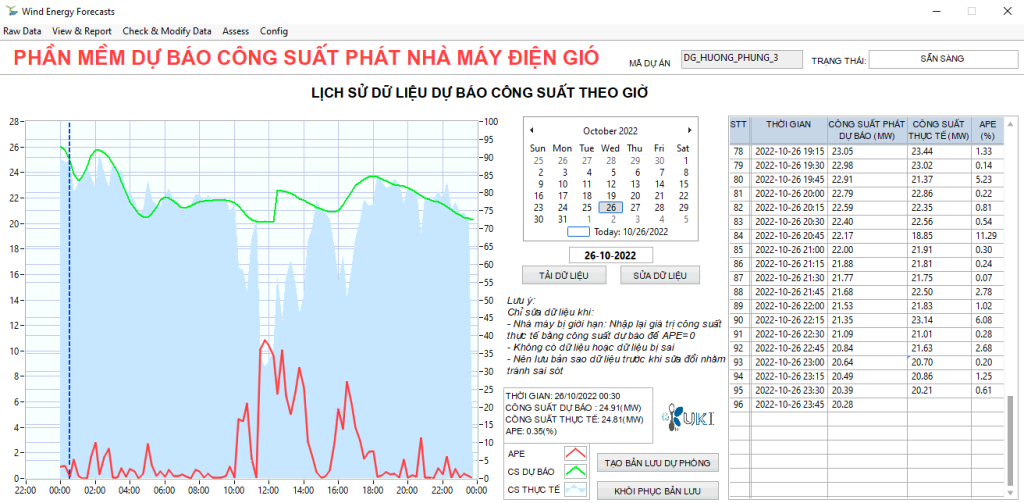POWER FORCASTING SOFTWARE SYSTEM
Power FC
1.Genral introduction.
Forecasting power generation is a key topic in energy management systems for planning the development of power systems, ensuring stability, and improving reliability. Since most renewable energy technologies depend on weather and environmental factors, accurately predicting power generation is challenging.
Electricity generation from renewable energy sources (RES), such as solar, wind, or ocean waves, has certain limitations. These sources generate electricity intermittently and inconsistently due to their high dependence on primary energy sources.
The availability of electricity is one of the major concerns in integrating renewable energy sources into the power grid, as solar energy does not generate power at night, and wind energy depends on wind speed.
2.Why we need this solution.
According to:
+ Decision 67/QĐ-ĐTĐL issued date August 10th, 2021 by ERAV on the promulgation of the Process for forecasting capacity and generating power of renewable energy sources.
+ The existing data lists for Agreement on Technical design of SCADA & Telecommunication systems at the project.
“Currently, according to regulations, power plants periodically announce their forecasted generation capacity for the next day and the upcoming cycle within the prescribed timeframe. After each announcement deadline, NLDC consolidates the forecasted generation capacity from A0 and the power plants for comparison in each operational cycle.”
- If the announced capacity of a power plant deviates by more than 15% for solar power plants or 20% for wind power plants compared to NLDC’s forecast, A0’s forecasted capacity will be used as the basis for scheduling.
- If the deviation does not exceed 15% for solar power plants and 20% for wind power plants compared to NLDC’s forecast, the plant’s announced capacity will be used as the basis for scheduling.
- According to the above principles, to maximize the allocated generation capacity, a power plant needs to predict the figure that A0 will announce and add a certain percentage to optimize the forecasted capacity while ensuring it stays within the allowable error range of 15%-20%.
- The PowerFC system supports power plants in forecasting the generation capacity that A0 will announce. Specifically, the PowerFC system uses data published by NLDC on the SMOV platform to build forecasting models. It then utilizes weather forecast data from reputable global providers (e.g., Enfor, SolarGis) to deliver accurate near-term generation capacity forecasts.

Picture of Power FC software
3. System solution
Modeling the Solution for Power Plant Forecast Data
Weather forcast data
The forecasted weather data calculated in the above model will be published and accessible, with options to export data via the software interface. This serves as the input for the model to calculate and analyze the plant’s generation capacity
Modelling power data
Power Capacity Modeling: To calculate the plant’s generation capacity from forecasted weather data, the system gathers input information, including the design capacity, coordinates of key equipment locations, unit characteristic curves, and the availability of equipment at the plant. Finally, the calculated values are verified and adjusted using real-time power signals combined with A0’s forecast analysis to enhance the accuracy of the predictions.
Weather forcast data
Data Collection for Analysis and Forecasting: To support calculations and analysis before publishing weather data, the model collects initial information such as the plant name and coordinates within the system. This data is then used to gather weather forecast information from global meteorological sources. Additionally, to improve accuracy, weather stations within the project area or nearby projects will be connected to collect localized weather data.
Modelling power data
Data Collection for Analysis and Forecasting: To support calculations and analysis before publishing weather data, the model collects initial information such as the plant name and coordinates within the system. This data is then used to gather weather forecast information from global meteorological sources. Additionally, to improve accuracy, weather stations within the project area or nearby projects will be connected to collect localized weather data.
TECHNOLOGY PARTNERS
FUKI INVESTMENT AND TECHNOLOGY APPLICATION COMPANY LIMITED
K27/1 Ngu Hanh Son street, My An ward, Ngu Hành Son district, Da Nang
+84 355963021
contact@fukiita.com
OUR OFFICE




